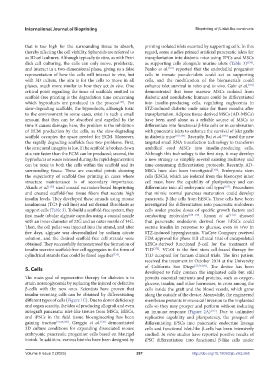Page 275 - IJB-9-2
P. 275
International Journal of Bioprinting Bioprinting of β-islet-like constructs
that is too high for the surrounding tissue to absorb, printing isolated islets escorted by supporting cells. In this
thereby affecting the cell viability. Spheroids are referred to regard, some studies printed artificial pancreatic islets for
as 3D cell cultures. Although typically in vitro, as with Petri transplantation into diabetic mice using EPCs and MSCs
dish cell culturing, the cells can only move, proliferate, as supporting cells alongside murine islets (Table 3) [154] .
and interact in a two-dimensional plane, giving us a false Penko et al. [161] reported that the endothelial progenitor
representation of how the cells will interact in vivo, but cells in mosaic pseudo-islets could act as supporting
with 3D culture, the aim is for the cells to move in all cells, and the modification of the biomaterials could
planes, much more similar to how they act in vivo. One enhance islet survival in vitro and in vivo. Gabr et al. [162]
critical point regarding the issue of scaffolds omitted in demonstrated that bone marrow MSCs isolated from
scaffold-free printing is the degradation time concerning diabetic and nondiabetic humans could be differentiated
which byproducts are produced in the process [151] . For into insulin-producing cells, regulating euglycemia in
slow-degrading scaffolds, the byproducts, although toxic STZ-induced diabetic nude mice for three months after
to the environment in some cases, exist in such a small transplantation. Adipose tissue-derived MSCs (AD-MSCs)
amount that they can be absorbed and expelled by the have been used alone as a reliable source of MSCs to
time it causes damage; here, the problem is the inhibition differentiate into functional β-like cells or in combination
of ECM production by the cells, as the slow-degrading with pancreatic islets to enhance the survival of islet grafts
scaffold occupies the space needed for ECM. Moreover, in diabetic mice [163,164] . Recently, Bai et al. [165] used the new
the rapidly degrading scaffolds face two problems. First, targeted small RNA transfection technology to transform
the structural integrity is lost if the scaffold is broken down umbilical cord MSCs into insulin-producing cells.
at a rate faster than the ECM can be produced; second, the Although this technology is the first step, it may develop
byproducts or waste released during the rapid degeneration a new strategy to simplify several existing multistep and
can be toxic to both the cells within the scaffold and its time-consuming differentiation protocols. Recently, AD-
surrounding tissue. These are essential points showing MSCs have also been investigated [166] . Embryonic stem
the superiority of scaffold-free printing in cases where cells (ESCs), which are isolated from the blastocyst inner
structure maintenance is of secondary importance. cell mass, have the capability of pluripotency and can
Akuch et al. [152] used coaxial extrusion-based bioprinting differentiate into all embryonic cell types [167] . Procedures
and created scaffold-free tissue fibers that secrete high that mimic normal pancreas maturation could develop
insulin levels. They developed these strands using mouse pancreatic β-like cells from hESCs. These cells have been
insulinoma (TC3 β-cell line) and rat dermal fibroblasts as investigated for differentiation into pancreatic endoderm
support cells (Table 3). To build a scaffold-free system, they cells under precise doses of specific growth factors and
first made tubular alginate capsules using a coaxial nozzle conducting molecules [168–170] . Kroon et al. [171] showed
with an inner diameter of 22G and an outer nozzle of 14G. that pancreatic endoderm derived from hESCs could
Then, the cell pellet was injected into the strand, and after secrete insulin in response to glucose, even in vivo in
five days, alginate was decrosslinked by sodium citrate STZ-induced hyperglycemia. ViaCyte Company received
solution, and the desired scaffold-free cell strands were FDA approval for phase I/ΙΙ clinical trial of encapsulated
obtained. They successfully demonstrated the formation of hESCs-derived functional β-cell for the treatment of
insulin secretor scaffold-free cell aggregates in the form of T1D [172] . VC-01 is the first stem cell-based therapy for
cylindrical strands that could be fused together [152] . T1D accepted for human clinical trials. The first patient
received the treatment in October 2014 at the University
5. Cells of California San Diego [55,56,160] . The device has been
developed to fully contain the implanted cells but still
The main goal of regenerative therapy for diabetes is to permits essential nutrients and proteins, such as oxygen,
attain normoglycemia by replacing the injured or defective glucose, insulin, and other hormones, to cross among the
β-cells with the new ones. Scientists have proven that cells inside the graft and the blood vessels, which grow
insulin-secreting cells can be obtained by differentiating along the outside of the device. Meanwhile, the engineered
different types of cells (Figure 1C). Due to donor deficiency membrane prevents immune cell invasion to the implanted
and organ scarcity, the idea of producing allograft and even cells so they may prosper and perform without inducing
autograft pancreatic islet-like tissues from MSCs, hESCs, an immune response (Figure 2A) [172] . Due to unlimited
and iPSCs in the field tissue bioengineering has been replicative capability and pluripotency, the prospect of
gaining traction [55,56,160] . Greggio et al. [136] demonstrated differentiating iPSCs into pancreatic endocrine lineage
3D culture conditions for expanding dissociated mouse cells and functional islet-like β-cells has been intensively
embryonic pancreatic progenitor cells based on Matrigel studied. In vitro studies have reported positive results of
bioink. In addition, various bioinks have been designed by iPSC differentiation into functional β-like cells under
Volume 9 Issue 2 (2023) 267 http://doi.org/10.18063/ijb.v9i2.665

